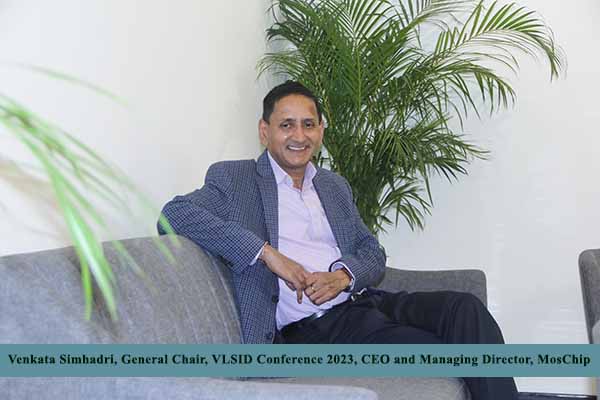International VLSI Design & Embedded Systems conference is a Premier Global conference with a legacy of over three and half decades. This Global Annual technical conference focuses on the latest advancements in VLSI and Embedded Systems. Over 2000 engineers, students & faculty, industry, academia, researchers, bureaucrats and government bodies are attending the conference. TimesTech interacted with Venkata Simhadri, General Chair, VLSID Conference 2023, CEO and Managing Director, MosChip to learn about the theme, companies that are participating and much more.
Read the interview here:
TimesTech: What can the industry expect out of this VLSID (Design & Embedded Systems) Conference 2023? What is the theme of this year’s conference?
Venkata: Governments around the world are increasing their investments in chips. The US Congress passed critical CHIPS Act investments totaling $52 billion to strengthen domestic semiconductor manufacturing and research. EU Chips Act also provides billions in financial support to set up factories for advanced chip production and semiconductor research.
Earlier this year, the Indian Ministry of Electronics and IT (MeitY), announced a $10 billion to support and boost the semiconductor industry in India. Along with the capital incentives to manufacturing as well as the DLI scheme for the Fabless startups. This is to develop products both for domestic and the global markets. With these announcements of policies in the background, the theme for this year is “Semiconductors Driving Disruptive Innovations in Global Digitations”. It will highlight the important role that semiconductor industries play globally in various sectors. For the first time post the covid pandemic, this will be a physical VLSI conference.
TimesTech: Who and which are the companies participating in this conference?
Venkata: The VLSID Conference 2023 is a collaboration with Government, industries & academia. While the Govt. of Telangana, AMD has been the Silicon Sponsors for the event, MeitY has been the Government Partner. Many leading semiconductor companies, such as Qualcomm, Intel, Western Digital, Siemens, Cadence, Global Foundries, Marvell, Transphorm and MosChip are also supporting the conference. In addition, LeadSoC and other startups along with VLSI training institutes, are participating.
TimesTech: What would be the contributing factor of this conference to the VLSI Design Sector?
The VLSI Design and Embedded System Conference is the premier international conference in India for showcasing research and development in the field of semiconductors and embedded systems. It attracts over 2,000 global attendees and involves participants from more than 100 organizations in the industry, government, and academia. The conference is a great opportunity to hear from industry leaders and network with others to support the local ecosystem.
TimesTech: Is the VLSI industry growing in India? How is the industry placed in India?
Venkata: As a country, we have made tremendous progress in the chip design sector. India is estimated to have around 120,000 chip design engineers, comprising about 20% of the world’s chip design workforce. Today almost every major semiconductor company in the world has a design center in India. However, India has little presence in the manufacturing ecosystem. It has the potential to expand with the support of the current semiconductor policy.
TimesTech: How are we leveraging our strengths and developing our own domestic strategy in making chips?
Venkata: We have been using our design expertise to create innovative intellectual property and products for multinational companies. However, there are currently no Indian fabless companies that are developing products for either the domestic or global market. It would benefit India to capitalize on our design skills and work towards establishing a fabless ecosystem shortly. Although the actual chips may be manufactured elsewhere, we can still package and test them locally. We are adding value to the process. India has the Semiconductor Complex Limited (SCL), the first fab in the country. It can be utilized for various applications that do not require the latest process nodes.
TimesTech: What is the latest significant invention in VLSI and embedded systems from India or elsewhere?
Venkata: The latest technology in VLSI and Embedded Systems is the new chip architectures and designs that are built and optimized for domain-specific functions. It includes the performance needs of artificial intelligence and machine learning.
RISC-V: There is an increasing momentum of the RISC-V, an open-source CPU architecture that has the potential to disrupt. India is heavily investing in this architecture. In fact, the Govt. of India declared RISC-V as national processor and funded RISC-V development at C-DAC and IIT-Madras.
Chiplets: A chiplet is a tiny integrated circuit that contains a well-defined subset of functionality. It is designed to be combined with other chiplets on an interposer in a single package. A set of chiplets can be implemented in a mix-and-match to produce a desired overall functionality. It is a major step up from the traditional system-on-chip (SoC) approach to semiconductor packaging. Major vendors are already producing computer processors that combine a select number of chiplets.
Embedded AI: The industry is fast approaching being the future of applied fields of Data Science and AI. By embedding intelligence in the cloud, network, edge and every kind of computing device, we unleash the potential of data to transform business and society for the better.
TimesTech: Do we have talents in India to catch up with the rapidly expanding VLSI Industry?
Venkata: India is a leading player in the VLSI industry, with a share of approximately 15% in global production. In addition, our country boasts an impressive talent pool of semiconductor design engineers. We are making up approximately 20% of the world’s total. Almost all of the top 25 semiconductor design companies have design and R&D centers in India. Our country’s strong demographics, talented workforce, and dedication to responsible economic growth present a unique opportunity to positively impact the world.
As India works towards becoming a global semiconductor hub, the initiatives of Digital India and Skill India will be instrumental in transforming the prospects of young Indians. Shri. Rajeev Chandrasekhar, Hon’ble MoS of the Government of India, highlightedthe same in a recent speech at Semicon India.
TimesTech: What Kind of openings are available for the VLSI Industry? How can engineers build their career in the VLSI Industry?
Venkata: The recently announced $10B India Semiconductor Mission (ISM) by the government is a resounding statement of intent. It is to gain a foothold in the $553 billion global semiconductor market. Budding engineers in India enter the semiconductor industry after a bachelor’s degree or a master’s degree in electronics, computer science, or electrical engineering. With India’s focus on investing heavily in semiconductor manufacturing, there is a need for material science engineers, chemical engineers, and even applied physics. With assembly plants expanding in India, there is a significant need for technicians and supervisors. Semiconductor jobs today offer an excellent salary and a distinguished career for engineers. These are a few commonly demanding jobs for the VLSI Industry:
- Design engineer
- Verification engineer
- Testing engineer
- Applications engineer
- R & D Engineer
- Product validation engineer
TimesTech: VLSI industry and the way forward, how important these conferences are, and how can conferences help in spreading knowledge about the fast-growing VLSI sector?
Venkata: Effective growth often relies on the collaborative efforts of various stakeholders. Conferences like these create an umbrella and a platform to showcase where we stand and what others think about it. This will help us interact with each other, share thoughts, criticize, discuss, debate, and finally conclude on a single note. For critical industries like Semicon, the involvement of government, academia, and the industry at a time are very important or there will always be a bottleneck and VLSID Conference is addressing that particular issue to bring all the policymakers under one umbrella.


















